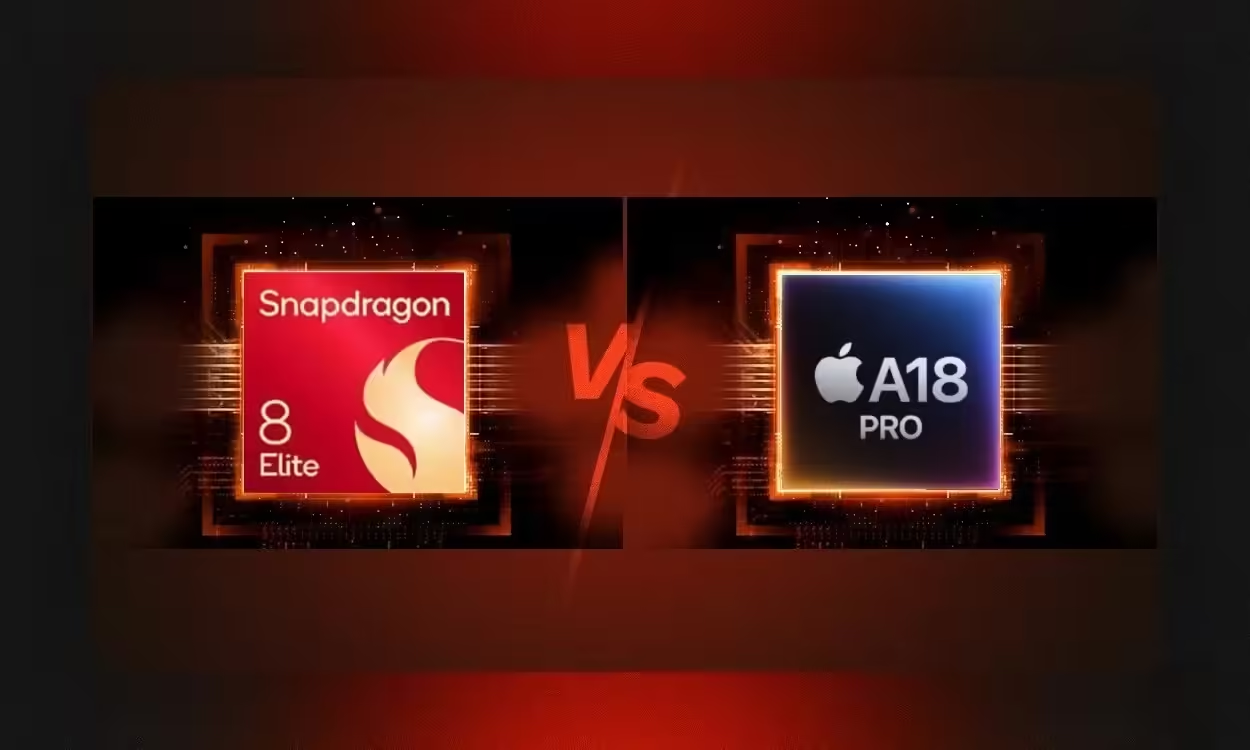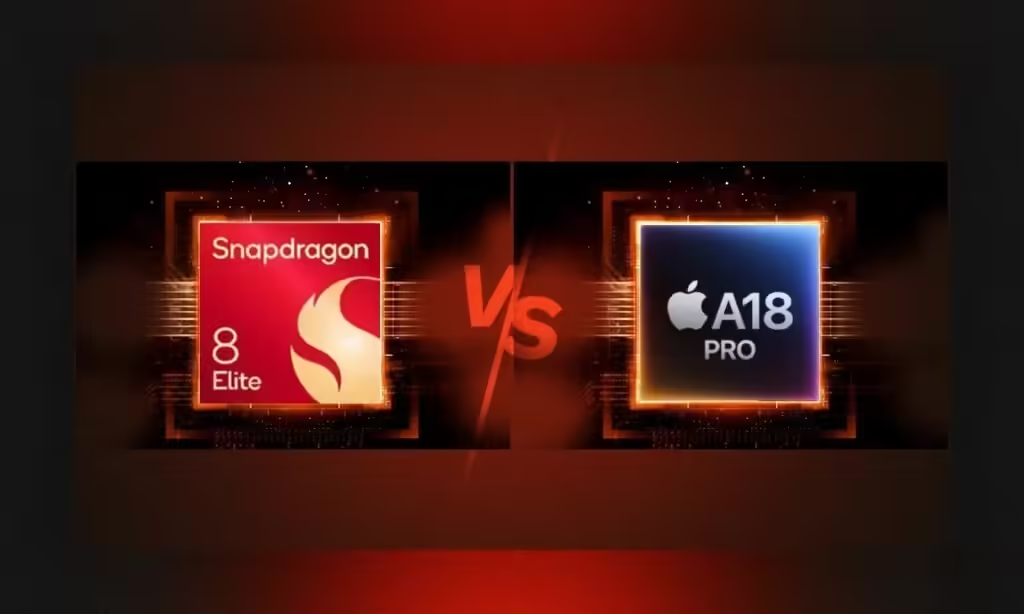
Qualcomm has launched its flagship Snapdragon 8 Elite processor, equipped with the second-generation Oryon CPU. The company asserts that this chipset has regained leadership for the Android ecosystem, challenging Apple’s dominance. To evaluate this claim, we’ve conducted a thorough comparison between the Snapdragon 8 Elite and the A18 Pro. Let’s delve in and determine which smartphone chipset reigns supreme.
Snapdragon 8 Elite vs A18 Pro: Specifications
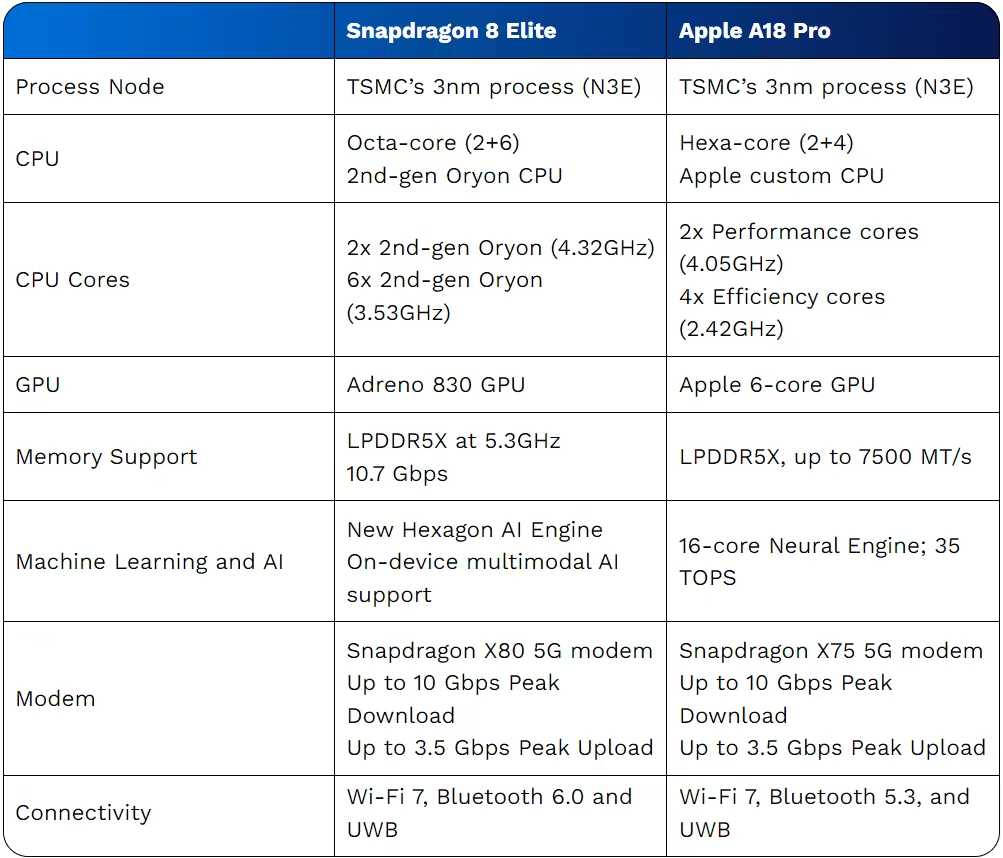
Snapdragon 8 Elite vs A18 Pro: CPU
The CPUs in the Snapdragon 8 Elite and Apple A18 Pro share several similarities. Both chipsets are manufactured on TSMC’s 3nm (N3E) process node and feature comparable CPU configurations. The Snapdragon 8 Elite utilizes a (2+6) CPU setup, while the A18 Pro has a (2+4) configuration, giving Qualcomm two additional CPU cores.
Additionally, like Apple, Qualcomm has eliminated the L3 cache, opting instead for a combination of L1, L2, and SLC caches. Notably, the L1 cache size is identical in both chipsets. This similarity is particularly interesting, considering that the Snapdragon 8 Elite’s Oryon CPU was designed by Gerard Williams, the former chief architect of Apple Silicon.
However, Qualcomm has incorporated a substantial 12MB L2 cache for the two Oryon prime cores and an additional 12MB L2 cache for the six Oryon cores, totaling 24MB of L2 cache. In comparison, the A18 Pro features a combined 20MB of L2 cache. Thus, the Snapdragon 8 Elite boasts the largest cache size among the two.

One notable architectural difference between the Snapdragon 8 Elite and the A18 Pro is that the former is based on the older Armv8 design, while Apple has adopted the Armv9.2a architecture for the A18 Pro. This allows the A18 Pro to utilize SME support, enhancing CPU performance for certain AI workloads. Consequently, the A18 Pro is expected to achieve higher scores on the latest Geekbench 6.3 benchmark due to this SME implementation.
In terms of CPU core design, the Snapdragon 8 Elite features the second-generation Oryon CPU cores, which are 57% more efficient and 30% more powerful than the first-generation Oryon CPU found in the Snapdragon X Elite.
As a result, the next-gen Oryon CPU in the Snapdragon 8 Elite delivers exceptional performance, even without SME support. Additionally, the Snapdragon 8 Elite boasts a maximum CPU clock speed of 4.32GHz, surpassing the A18 Pro’s peak frequency of 4.05GHz.
Snapdragon 8 Elite vs A18 Pro: Benchmarks
In our benchmark testing of the A18 Pro, it achieved scores of 3,358 in Geekbench single-core and 8,184 in multi-core performance. In comparison, leaked Geekbench results for the upcoming Xiaomi 15, which is powered by the Snapdragon 8 Elite, indicate a single-core score of 3,213 and a multi-core score of 10,093.

Although the Snapdragon 8 Elite has a higher clock speed, the A18 Pro maintains a slight edge in single-core performance, leading by about 5%, likely due to the advantages of SME support. However, with its eight Oryon cores compared to the six in the A18 Pro, Qualcomm delivers 23% better multi-core performance. It’s important to note that these are preliminary figures, and retail units typically score lower than the initial leaked benchmarks.
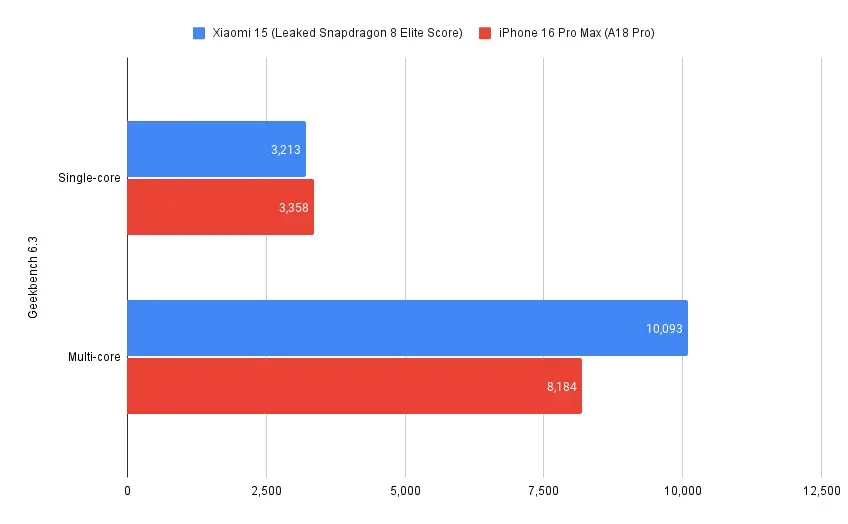
Geekerwan (check out) has shared some intriguing benchmarking results for the Snapdragon 8 Elite on Qualcomm’s Reference Device (QRD). In the Speedometer 3.0 test, which assesses webpage responsiveness, the A18 Pro outperforms the Snapdragon 8 Elite by 6%. This is a significant improvement, considering that the previous gap with the Snapdragon 8 Gen 3 exceeded 50%.
In the Geekbench multi-core test, the Snapdragon 8 Elite demonstrates slightly better performance than the A18 Pro at the same power level (12W). This marks the first time Qualcomm’s CPU has surpassed Apple in terms of performance per watt.
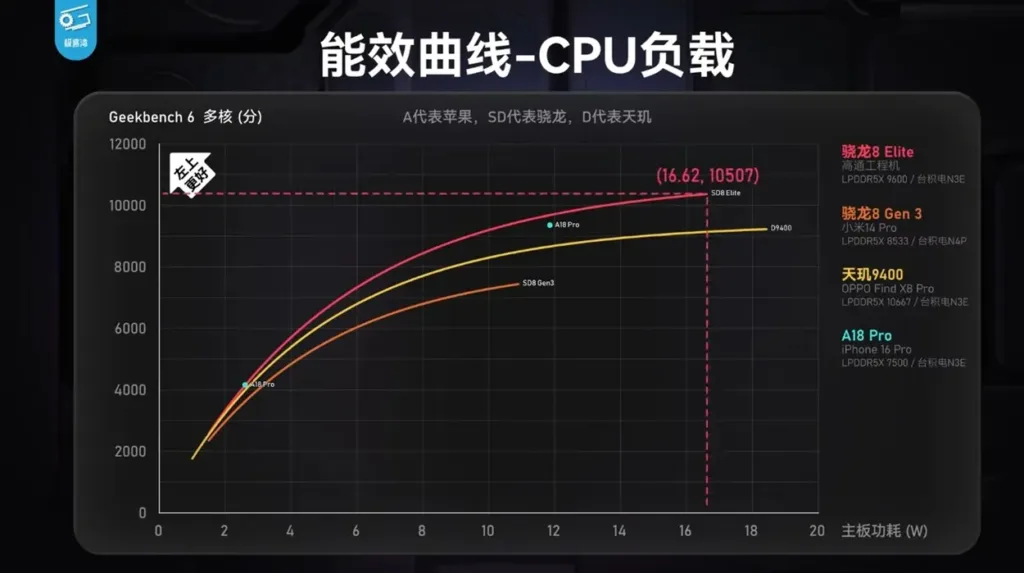
Furthermore, the Snapdragon 8 Elite can consume up to 17W to achieve top CPU performance on mobile devices, surpassing 10,000 points on Geekbench. When operating under 10W, the Snapdragon 8 Elite scores approximately 9,000 points.
In terms of single-core performance, Xiaobai (check out) indicates that the A18 Pro provides around 10% better performance than the Snapdragon 8 Elite while drawing only 6.6W, compared to the Snapdragon 8 Elite’s consumption of nearly 7.6W. This indicates that Apple continues to lead the industry in single-core performance.

In summary, the second-generation Oryon CPU cores are not only powerful but also highly efficient. Although the Snapdragon 8 Elite lags slightly behind the A18 Pro in single-core performance, Qualcomm now appears to have a genuinely competitive CPU that can rival Apple’s A-series processors.
Snapdragon 8 Elite vs A18 Pro: GPU
In the GPU department, the new Adreno 830 GPU on the Snapdragon 8 Elite truly excels. Qualcomm has been ahead of Apple in mobile graphics performance for the past two generations, and with the Snapdragon 8 Elite, it has further solidified its lead.
The introduction of a new Sliced architecture allows each of the three GPU slices to be clocked up to 1.1GHz. This results in a 40% overall improvement in graphics performance, with ray tracing performance also seeing a 35% boost. Additionally, Qualcomm has incorporated 12MB of GMEM (Generalized Memory Management) into the GPU for faster rendering capabilities.
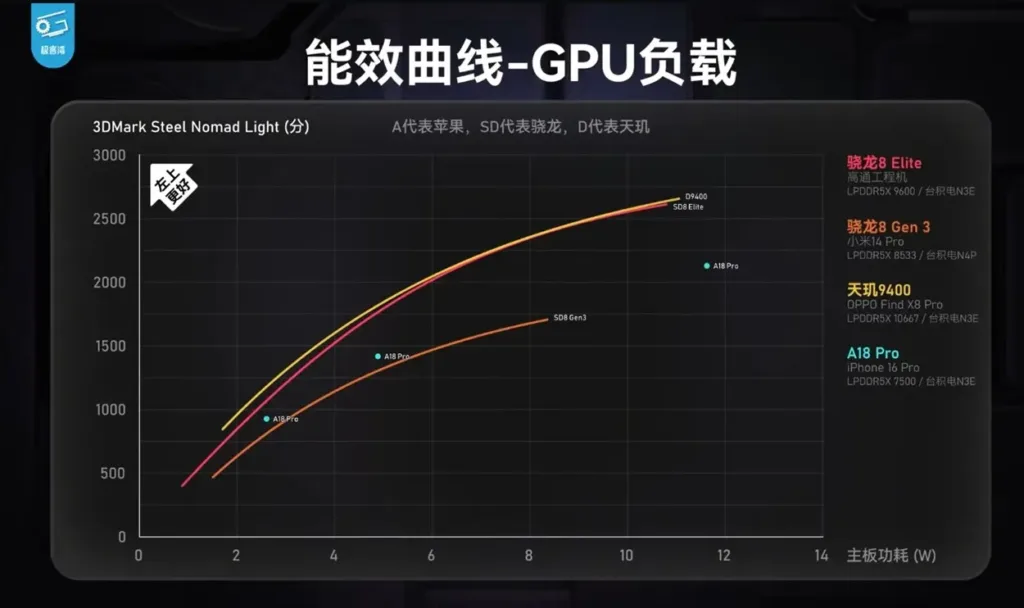
Geekerwan reveals that in the 3DMark Steel Nomad Light test, the Adreno 830 GPU on the Snapdragon 8 Elite outperforms the A18 Pro’s 6-core GPU while consuming less power.
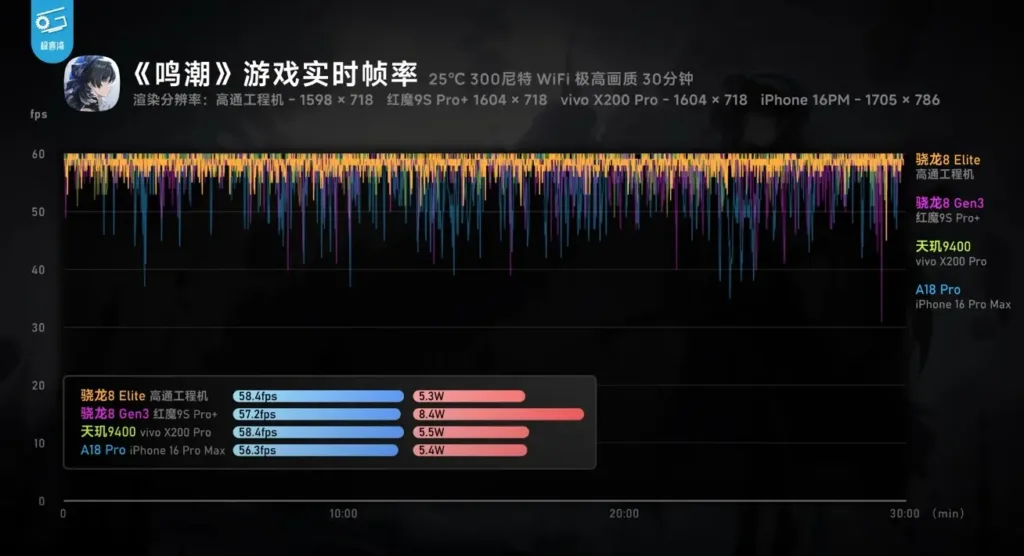
In the game Wuthering Waves, the Snapdragon 8 Elite achieves 58.4 FPS with a power draw of 5.3W, compared to the A18 Pro’s 56.3 FPS at 5.4W. Similarly, in Honkai: Star Rail, the Snapdragon 8 Elite’s GPU matches the performance of the A18 Pro’s GPU at the same power level.
Snapdragon 8 Elite vs A18 Pro: NPU
Finally, regarding the NPU, Qualcomm claims that the new Hexagon NPU on the Snapdragon 8 Elite can process over 70 tokens per second when running large language models (LLMs) on the device. It also benefits from faster dual-channel LPDDR5X memory, capable of reaching speeds up to 10.7 Gbps. However, Qualcomm has not revealed the TOPS figure for the NPU in the Snapdragon 8 Elite.
In contrast, Apple’s 16-core Neural Engine on the A18 Pro can deliver up to 35 TOPS. While it’s currently challenging to compare the NPUs of both chipsets directly, we will soon conduct Geekbench AI tests and share the findings with our readers.
Snapdragon 8 Elite vs. A18 Pro: Has Qualcomm Finally Made Its Mark?
With the second-generation Oryon CPU, Qualcomm has made significant strides in performance and efficiency, especially when comparing the Snapdragon 8 Elite to last year’s 8 Gen 3. However, Apple still maintains an edge in single-core CPU performance.
While the Snapdragon 8 Elite excels in multi-core results, thanks in part to its additional two cores, the A18 Pro manages to outperform it in single-threaded tasks, despite having slower memory and lower clock speeds, all while consuming less power.
In terms of GPU performance, the Snapdragon 8 Elite outshines the A18 Pro, highlighting the need for Apple to significantly enhance its GPU architecture. In summary, while the gap has narrowed considerably, Qualcomm’s assertion of reclaiming leadership in the Android ecosystem isn’t fully realized yet, particularly regarding CPU performance.
